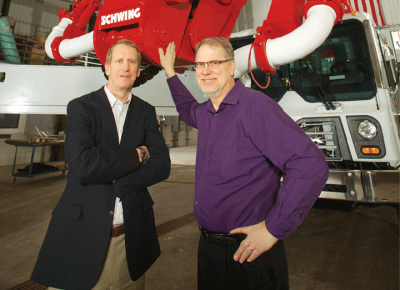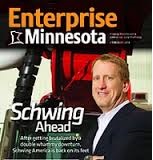Leadership Catalyst Blog

Schwing USA charges back – 10 Lessons for leveraging Chapter 11
All Blog Posts, Change, Strategy / 19.03.2014
A hallmark of an effective CEO Peer Group is having members with a diverse set of experiences. A CEO mix featuring a variety of industries, company sizes, and life cycle maturity stages creates a brilliant wealth of knowledge that members can draw on to assist in whatever challenges they are currently facing. As some Vistage members have quipped, it’s nice to have the opportunity to learn from someone else’s mistakes rather than to make them all yourself.
My Minneapolis Vistage groups include several Fast50 members, a Power50 member, the 2013 Manufacturer of the Year and a perennial “Best Place to Work” winner. CEOs are going to have a lot of ups and downs in their careers just like anyone else, and CEOs need a forumthat can help us through the bad times as well as the good. Our CEO Advisory Board is fortunate to include Brian Hazeltine, CEO of Schwing America, who was featured last month on the cover of Enterprise Minnesota for leading his company back from the brink of financial ruin.
Read Schwing Ahead in the February issue of Enterprise Minnesota® magazine.
As Lynn Shelton, Enterprise Minnesota’s Director of Marketing & Communications, writes in their February 21,2014 e-Trends newsletter:
“In September 2009, just two weeks after taking over as CEO, Hazelton brought the company into Chapter 11 bankruptcy protection, just one more move in what our profile called “an almost surreal litany of recession-related poor timing and bad luck that forced the nation’s leading manufacturer of concrete pumps to spend more than four years in a corporate bob and weave,” waiting for the housing industry to bounce back.”
During the housing boom ten years ago Schwing was racing to keep up with demand. At its peak, Schwing grew to 680 employees and ran its 400,000 square-foot facility in White Bear Township 24/7. When the construction industry bottomed out, Schwing had to lay off close to 600 employees and close its in-house paint operation, welding shop and fabrication facility. The story of how Hazelton and his team nimbly managed through, creatively leveraging the Schwing brand and keeping close to its customers (who were also enduring a difficult time) is an inspiration.
Here are few key lessons Brian Hazelton of my Minnesota Vistage group can teach us about surviving a “perfect storm” and repositioning his company to thrive and double next year.
1) Believe in your product strongly enough to fight for it even when the universe seems to be turning against you
2) Beware of unrelated but compounding converging trends
3) When there is a will there is a way – the drive to survive can move mountains
4) Be willing to take on multiple jobs when times are tough
5) Don’t be afraid to reinvent yourself
6) While Chapter 11 is nobody’s first choice, it can be the best strategic option when you are not left with many paths forward
7) Don’t forget about your customers even when they aren’t buying
8) Help your customers sell your product
9) If you don’t tell your story when times are tough, somebody else will and odds are you won’t like their version as well
10) Paying it forward can bring about payback – loyalty is a form of Karma
Read More >>
5 Keys to Overcoming the Challenges of Discontinuous Innovation
All Blog Posts, Change, Vistage Peer Groups / 20.02.2014
The past decade is littered with cases of companies who were on top of their industry one year and then suddenly found themselves struggling to stay alive. Blackberry, Borders, and Blockbuster are three that come immediately to mind. When you read about them in the media or in HBR case studies, it is hard to fathom how they missed the new technology that put them on life support, if not out of business. The phrase “discontinuous innovation” refers to a paradigm shift in technology and/or the market structure of an industry. We can learn a lot from the examples of CEOs who have successfully navigated these disruptive changes.
Minneapolis Vistage member Jay Coughlan offers some insights into why change and organizational transformation is so difficult. He has led his company, XRS through 2 major transformations since 2007, and his story is summarized in a recent Minneapolis Star Tribune article. Below is the quote from the article that provides the background story.
“In 2009 the company, then called Xata, acquired Toronto-based Turnpike Global Technologies, which provided a trucking compliance solution that ran through a handheld device. Truckers and their companies must comply with myriad regulations, from logging hours driven and duty status to tracking state fuel taxes. The XRS service also helps improve performance by keeping track of maintenance schedules, fuel economy and more.
That $20 million acquisition would be the foundation of a complete shift in the company’s approach to providing logistics for the trucking industry. Xata used to be primarily a hardware company that installed a communications dome on top of truck’s cab and then tore apart the dashboard for a four-hour installation of a fixed-panel display and keyboard.
Now, with its mobile technology, it takes about 10 minutes to connect its XRS relay device and sync it with a wide variety of Android and Windows Mobile smartphones, rugged handheld devices and tablet computers that will automatically transmit vehicle and operator data directly to a management dashboard in the cloud. “
In hindsight, this migration from hardware to mobile technology seems like a no brainer, but with discontinuous innovation, there were three powerful stakeholders that made such a transformation almost impossible.
Existing customers – XRS had a large customer base on their legacy hardware with huge sunk costs who wanted them to continue to support that system. They are less than sympathetic to the need for XRS to shift resources from supporting their legacy systems to the development of the new technology.
Shareholders and Investors – Migrating to mobile required a change in business models from a large upfront equipment sale and installation to a subscription model with no upfront revenues. Moving from one to the other means a huge decline in revenues and profits over a year or more, which translates to meager cash flow, and short term losses. Even when you forecast it on paper, it is difficult to maintain the commitment of your board and investors when you are in the middle of it, especially when there is no guarantee of long term success.
Company Leaders and Employees – Migrating from a hardware solution to a software solution, to ultimately a mobile solution required totally different skillsets in engineering, software development, and sales and was only possible with a 70% turnover of employees. Without a clear vision and a burning platform for change it is impossible to drive the changes required to support this kind of transformation.
Based on many monthly coaching sessions and CEO peer meetings with Jay, I have identified 5 Keys that enabled XRS to overcome stakeholder resistance.
- Communicating a compelling vision of the power of being a first mover in his industry with mobile technology. The message needs to be simple and re-communicated over and over to remind people where we are going.
- Creating a “burning platform” (sense of urgency) around how iPads, tablets, and smart phones were discontinuous innovations that could render their current system obsolete – XRS needed to make the leap or be left in the dust. Again, given the dramatic changes required, people need to understand and be reminded that there is no going back to the old technology.
- Developing realistic quarterly forecasts showing the revenue lines of their two platforms and when the lines would cross and then producing quarterly results that are consistent with the forecast. This is especially difficult because there is no trend data to rely on and forecasts need to be frequently updated.
- Hiring new leaders that are equipped to drive the changes required in sales, technology, and operations. These new leaders need to represent the new culture you are creating and also integrate well with the former leadership team members that are still on board.
- Identifying the three critical priorities every quarter to drive the organization through the next phase of change. These priorities can change as you encounter bumps in the road along the way, and these changes need to be clearly communicated to all stakeholders.
Jay’s leadership in overcoming stakeholder resistance during XRS period of discontinuous innovation is an excellent example of the courage and resiliency required for CEOs to lead their companies through major transformation. I really enjoy having Jay in my Vistage CEO Advisory Group and his insight is extremely valuable to other group members who may be facing a similar rocky road. Vistage provides an excellent forum for CEOs to learn from other CEOs who have been where they are going.
Read More >>


